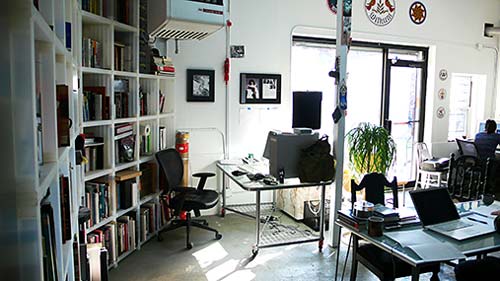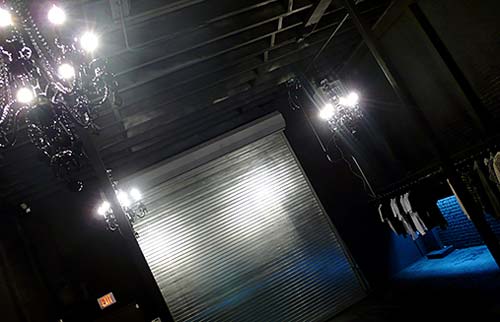

“I want to destroy systems. Then maybe something better will grow in their place.”-David Gensler
this press was first published
in WGSN over 3 years ago
WGSN interviewed David Gensler a few days before resigning his post as chief executive officer of Native, the in-house creative solutions agency for The Roc, a family of brands built by Damon Dash, founder of Rocawear apparel. For those who know Gensler, his departure wasn’t surprising. He doesn’t like to sit still or rest and only sleeps four hours a night. When the market moves, so does he, which is why he is always a part of projects that set trends, rather than following them. The service he offers provides an insight and understanding of today’s global marketplace, how to tap it, harness it and make it work for a client’s bottom line, with Madonna, Eve, Beyoncé Knowles and BMW previously seeking his help.
He doesn’t mind being called an expert of the urban market, but just don’t call it urban, which he says is an outdated term.
“Ten years ago [the urban market] was in its infancy,” said Gensler. “It was a culture that was literally getting its footing, especially on the commercial side of the cultural fence, but now it is has reached its second age where a lot of the founders are all grown up and running multimillion-dollar global companies. As with any culture, this one has evolved and is now regenerating itself. The evolution right now is more about its maturity.”
This maturity is why the word “urban” is also no longer applicable.
Mash culture
“The term we use now is mash culture. We stole that from the music industry in the UK,” said Gensler about the creation of new music from borrowing and stealing (for example, the work of 2ManyDJs or Richard X).”That is what youth culture is about today – borrowing from previous generations and creating this kind of mish-mashed, customised culture that involves hip hop, action, sports, and is very much involved in fashion, music, entertainment and content development. Mash applies more than urban because a lot of the consumers that push forward this urban marketplace don’t live in cities.”
Mash market, today’s youth market, is far more encompassing and far-reaching than just trends permeating the US, such as the growing Hispanic and Asian influences. It is instead a ubiquitous value system suited for an interconnected audience.
“It has nothing to do with your skin colour, your religion, or your geographic location,” said Gensler. “It has to do with a style sensibility and a way that people approach things. It’s youth-driven, not urban. Hip hop is just a part of the thread in the fabric of youth culture. It is 100% not about a black market or anything like that. If you stay focused on making a great product with value you can stay apart of the fray.”
The revival of the Cadillac’s Escalade car is a classic example. At a recent seminar in Las Vegas, Irma Zandl, president of Zandl Corp, commended the brand’s rebirth saying, “They turned my grandmother’s car into a hot urban brand.”
Gensler agreed, but used this example to hammer in his point. The reinvention was about good design, not about targeting a segment of the urban market.
“You can’t tell me that conservative designers at General Motors actually said, ‘Let’s design a hip hop car.’ Or the designers at Louis Vuitton said, ‘Let’s design a hip hop bag.’ They design a beautiful functional product and people respond to that. IIt is an aspirational market. It’s not rocket science. Hispanics like to shop. It is just math – math driven by media.”
GlobalisationRight now hip hop is at the top of its game enjoying that media spotlight, as is the growing Hispanic influence, but those will fade, warns Gensler, because the next big thing is always just a heartbeat away waiting for its turn.
“Action sports is way bigger,” said Gensler. “How many products are directly associated with hip hop? Music, film, and fashion. How much is associated with action sports? Action, music, fashion, film, and $10,000 jetskis. Every time a kid gets new gear to go snowboarding he spends money to buy his gear, and another $1,000-1,500 to buy lift tickets.”
The mash of action, sports, and fashion into a sleek innovative product is why Puma is one of his favourite companies.
“I have seen incredibly young people rocking Puma and I have seen really cool old dudes rocking Puma. They understand product development. They take risks. They are bold. They are not following trends,” said Gensler.
Those who get the urban or the youth market concept right are those who understand globalisation. The process of globalisation continues to unify the world at ever-increasing speeds, transporting fashion, music, and cultural trends almost as fast as the financial markets can move capital across nations and time zones.
“Everything is about information and speed. The trends are global. The consumption patterns are global,” said Gensler. And in order to create products for the connected customer you have to be tapped into technology.
Companies getting it right
“We were isolated before and that is what created these clusters and created things like demographics and very speciality psychographics, but it really doesn’t have anything to do with urban or a hip hop thing. It is just about innovation and speed – bringing things to the marketplace faster than anyone else. That is a 100% technology answer. Everyone is a photographer and a designer today. You put an eight megapixel camera in the hand of an eight-year-old and the pictures will look good.”
But innovation and technology alone are not the answers. Corporate culture and a willingness to understand the pace of change are crucial. Take the auto industry, one of Gensler’s favourite sources for innovation.
“Probably some of the greatest designers in the world are in the auto industry,” he proclaimed. “The head of Ford’s design [J Mays] understands more about fashion than the people at Calvin Klein and Tommy Hilfiger. The head designer at BMW [Chris Bangle] is probably one of the most innovative designers on earth.”
Their problem is not innovation, but speed. Auto companies are mired by such impossibly slow product development cycles that the ideas have no impact once they reach the market.
And where the auto industry wins at innovation and fails at speed, the men’s urban apparel market wins at speed, but fails miserably at innovation, proving there can’t be a winning formula – regardless of the product – without both being in sync.
“There is so much copying of other people’s styles it personally just makes me sick,” said Gensler about the men’s urban apparel market. “Everyone literally sees the brown, orange, and white colour story and suddenly the whole world uses brown, orange, and white. These people are not designers. They are basically graphic stylists. It is so boring.”
The market is devoid of ideas and he blames that in part on the frenzy over celebrities. Apparel companies are trying to hard to react quickly to them and failing to realise it is about designing a quality, innovative product.
Although celebrity affiliation and star power is still hugely important to marketing a product or building a brand, “when it is done right it is very popular, but it can go wrong. Look at what Arnell did with Celine Dion.”
There are a few companies getting it right though. He named Stone Island, CP Company, Y-3, Triple Five Soul, Zoo York, Dave’s Quality Meat and Final Home, the Japanese brand that evolved from Issey Miyake Inc.
“Nike is always just killing people with how innovative they are.” DC Shoes, which was purchased by Quiksilver, “is very hot. It is probably one of the most original apparel companies out there. No one covers them unless you’re covering skateboarding, but just in terms of fashion that brand is awesome.”
Gensler on his own
As for Gensler’s own future, now that he has resigned from The Roc, he intends to get up off the advisory couch and get involved in the action.
He has plans to buy a magazine and morph it into his own vision, launch a luxury street fashion brand, a footwear brand, and a boutique in Beverly Hills.
“All of this is in actual development, not just hot air. It will all be launching in summer,” he said.
He is currently in discussion with Karim Rashid, a man with “one of the best design minds in the world”, about collaboration on several projects, including a possible furniture line.
via: wgsn








{ 1 } Trackback
Readed…
Television is a device that permits people who haven’t anything to do to watch people who can’t do anything…